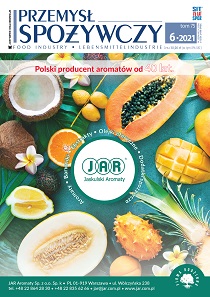ECONOMY
- 2 Sector of Fruit and Vegetable Juices and Beverages in Poland – Iwona Szczepaniak, Bożena Nosecka (DOI 10.15199/65.2021.6.1)
The article presents the level and changes in the production of concentrated juices as well as fruit and vegetable drinking juices, nectars and beverages in Poland in the years 2011-2020. The trends in the consumption of these products in Poland against the background of the European Union are also presented. Moreover, the position of the Polish juice and beverage sector among other EU countries was assessed. The analysis shows that the share of drinking juices in the structure of domestic production is growing at the expense of concentrated juices. This is largely due to the growing demand for drinking juices in the country, but also to increasing exports of juices directly pressed from fruit, mainly apples. At the same time, Poland’s position is strengthening as one of the EU’s most important producers and consumers of juices. In terms of the value of juice production, Poland ranked high, third position, and in terms of juice consumption per person, it was in the fifth place in the EU. The financial results of producers, despite the deterioration in the last year, ensured the companies’ operational security
KEY WORDS: juices, beverages, production, consumption, economic-financial situation, Poland, European Union
LAW
- 12 Analysis of the Epidemiological Situation Based on EFSA Reports – Agnieszka Jackowska-Tracz (DOI 10.15199/65.2021.6.2)
Zoonotic pathogens account for 60% of all human pathogens. In the EU, infections caused by Campylobacter, Salmonella, STEC, Yersinia, Listeria are among the most frequently reported zoonoses in humans. Campylobacteriosis is the most commonly reported gastrointestinal infection in humans in the EU since 2005. In 2019 over 220,000 Campylobacter infections were reported, representing 50% of all the reported cases. Based on the data of the course of diseases, it was concluded, that listeriosis was disease with the worst course and the highest mortality. In 2019, there were 5,175 foodborne outbreaks resulting in more than 49,000 illnesses, nearly 4,000 hospitalizations and 60 deaths.
KEY WORDS: Campylobacter, Salmonella, STEC, Yersinia, Listeria, foodborne infections, food-borne outbreaks
TECHNICS – TECHNOLOGY
- 21 Asaia Sp. – A Unique Type of Acetic Acid Bacteria – Dorota Kręgiel (DOI 10.15199/65.2021.6.3)
The acetic acid bacteria of the genus Asaia are widespread in nature. Their natural habitat is tropical flowers and fruits. Literature data indicate the presence of these bacteria also in Europe, mainly as contaminants of non-alcoholic beverages produced with the addition of juices or flavors. The growth of Asaia sp. bacteria causes unfavorable sensory changes in the products, mainly turbidity and fluff formation. Due to their strong adhesive capacity and the formation of extracellular polymer compounds, they can form biofilms, which are difficult to remove contamination of production lines. However, other properties of these bacteria have also recently been discovered as anatural symbiote of nectarious insects, including agricultural parasites. Given the natural process of transmission of these bacteria, there is an unprecedented possibility to directly or indirectly use antipathogenic Asaia sp. Strains in transgenic strategies to control many crop pests. This article reviews the literature on Asaia acetic bacteria, especially their ecology and unique adaptive properties that allow them to develop in various environments. This review claims that the ecology of these bacteria has great potential that can be exploited.
KEY WORDS: AAB, Asaia, drinks, biocontrol factors
FOOD – FEEDING
- 29 Characteristics and Evaluation of The Composition of Selected Dietary Supplements Supporting the Circulatory System – Karolina Jeż, Anna Piotrowska, Katarzyna Świąder, Joanna Rachtan-Janicka (DOI 10.15199/65.2021.6.4)
The most common cause of premature death in the Polish population is cardiovascular disease. Increasingly, on the Polish market you can find dietary supplements whose active ingredients prevent morbidity and reduce mortality from these diseases. The paper analyses selected market dietary supplements with prophylactic properties and supporting therapy in cardiovascular diseases, containing hawthorn and horse chestnut. Many of the available dietary supplements contained doses of active substances in concentrations lower than scientifically proven prophylactically and/or therapeutically effective, which meet the legal criteria for this type of food that cannot have therapeutic properties. At the same time, consumers with cardiovascular diseases using supplementation may not obtain the expected, beneficial, health effects from its use.
KEY WORDS: dietary supplement, cardiovascular diseases, hawthorn, horse chestnut
- 38 Black Cumin Nigella Sativa L – A Valuable Raw Material for Oil Production – Natalia Karwat, Małgorzata Wroniak (DOI 10.15199/65.2021.6.5)
Cold-pressed oils are characterized by an intense color, and very often a specific taste and smell. They are a source of valuable polyene fatty acids, but also bioactive ingredients, including tocochromanols, phytosterols, carotenoids, chlorophylls, phenolic compounds and some essential oils as well. There are still new, previously unknown oils on the market, derived from unusual raw materials, e.g. black cumin seeds. Black seed oil is a very good source of polyenic acids (mainly linoleic acid). In addition, it contains thymoquinone, the main component of the essential oil, which exhibits a broad spectrum of biological properties. Thus, black seed oil may have a prophylactic effect against civilization diseases, thanks to its antioxidant, anti-inflammatory and antibacterial properties.
KEY WORDS: black cumin seeds, cold-pressed oils, fatty acid composition, tocopherols, sterols, thymoquinone
- 44 Consumer Perceptions of Products with An Expiration Date – Robert Nicewicz, Beata Bilska (DOI 10.15199/65.2021.6.6)
Buying and consuming food is an indispensable, everyday part of human life. When shopping, consumers often choose food based on, inter alia, the expiration date on the package. The survey was carried out using the CAWI method on 200 respondents. The aim was to analyse consumer perception of products with expiry dates. A high percentage of Poles were reluctant or rather un[1]willing to buy products with an expiry date. Consumers checked the expiration date most frequently on less durable products such as meat, cold cuts, fish, milk and milk products. The vast majority of respondents knew the definition of a product labeled „best before”, but about 20% of respondents had some difficulty in classifying the right kind of food for such a label. Most were wary of foods with a short shelf life and tried not to buy them.
KEY WORDS: expiry date, consumers, food products, survey research
EXPERT
- 51Trends in the alcoholic beverages market
MEMORY
- 54 Edward Kajdański – memory
EVENTS
- 50 Bottled or tap water?
- 53 New generation fiber and stevia – the sugar revolution in food products
- 55 Yeast protein – a game changer on the protein supplement market!




